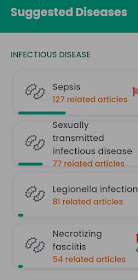QUESTION-1): An 81 year old male presents by ambulance to the emergency room for evaluation of new onset confusion. Which of the following is appropriate?
ANSWER:
Bacterial and candidiasis sepsis, treatment including broad spectrum antibiotics.
Heart failure hypotension treatment with dobutamine. Hypoxia treatment with oxygen supplement.
KAHUN only gives ASSESSMENT/ DIAGNOSIS, once diagnosis is listed, the treatment is from the References. In general, It is the ASSESSMENT, DIAGNOSIS of the case that pins exact TREATMENT.
There are some other applications comparable to KAHUN application abilities, but also include TREATMENT strategies such as isabelhealthcare diagnostic application.
HISTORY of the case as given in question1.
"He has a history of hypertension,
type 2 diabetes mellitus,
hyperlipidemia, and
congestive heart failure.
Past Medication as given in question-1.
He takes
metformin,
lisinopril, and
pravastatin.
as given in question-1.
He lives in a nursing home.
He appears acutely ill and confused about the date and place.
Vitals as given in question-1.
His blood pressure is 90/60 mmHg.
His heart rate is 92 beats per minute, and his respiratory rate is 22/minute.
His temperature is 35 degrees C.
Sa02 is 92%.
Physicals as given in question-1.
He has crackles in his lung bases. Auscultation of the heart reveals a regular rhythm (without murmur, rub, or gallop). "
_______________________
Above quoted case is an medical exam question. KAHUNs answer should give likely diagnosis and appropriate treatment plan will be found using kahun's results.
Let's see how KAHUN will do on this question.
At first the information from above case is written in KAHUN SCREENS as below. Then KAHUN made following ASSESSMENT as Shock and Sepsis, and asked for further work regarding the patient.
KAHUN SCREENS
Review of systems
The patient is also suffering from disturbance of orientation (duration 1 days) and fatigue.
History of present illness
Male, 81 years old, presenting with confusion for a duration of 1 days. Patient describes the confusion as sudden. Patient has skin problems.
Patient has medical history of: Dyslipidemia, HTN - Hypertension, diabetes mellitus type 2 and chronic heart failure.
Habits: Sedentary lifestyle.
Medications: Metformin, ACE inhibitor and atorvastatin.
Physical examination
Vital signs: low body temperature, low spo2%, low systolic bp, low diastolic bp and high respiratory rate.
Cardiovascular: decreased cardiac function.
Respiratory: respiratory crackles (location structure of base of lung).
Gastrointestinal: None.
Neurological: None.
Musculoskeletal: None.
Skin: crust on skin and rash (appearances papulovesicular rash, bullous and cutaneous eruption).
Genitourinary: None.
HEENT:
None.
Other: hypoxemia (severity moderate).
Assessment:
Patient presenting for evaluation of confusion. Patient has associated symptoms of disturbance of orientation and fatigue.
Vital signs revealed low body temperature, low spo2%, low systolic bp, low diastolic bp and high respiratory rate.
Physical examination is normal except for: hypoxemia, crust on skin, rash, decreased cardiac function and respiratory crackles.
KAHUN ANSWER to the QUESTION-1)
Diagnosis is most consistent with shock.
Other possible causes to be considered include sepsis.
KAHUN
TREATMENT of CONGESTIVE HEART FAILURE(Courtesy of Mayoclinics)
- Angiotensin-converting enzyme (ACE) inhibitors. These drugs relax blood vessels to lower blood pressure, improve blood flow and decrease the strain on the heart. Examples include lisinopril (Zestril, Qbrelis, Prinivil) and captopril.
- Angiotensin II receptor blockers. These drugs, which include losartan (Cozaar), valsartan (Diovan) and candesartan (Atacand), have many of the same benefits as ACE inhibitors. They may be an option for people who can't tolerate ACE inhibitors.
- Beta blockers. These drugs slow heart rate and reduce blood pressure. Beta blockers may reduce signs and symptoms of heart failure, improve heart function. Examples include carvedilol (Coreg), metoprolol (Lopressor, Toprol-XL, Kapspargo Sprinkle) and bisoprolol. Aldosterone antagonists. help people with severe systolic heart failure live longer.
- Diuretics. make urinate more frequently. Diuretics, such as furosemide (Lasix), also decrease fluid in lungs
- Positive inotropes. These medications may be given by IV to people with certain types of severe heart failure who are in the hospital. Positive inotropes can help the heart pump blood more effectively and maintain blood pressure. Long-term use of these drugs has been linked to an increased risk of death in some people. Dobutamine is an example of inotropic drug.
- Digoxin (Lanoxin). This drug, also called digitalis, increases the strength of heart muscle contractions. It may be more likely to be given to someone with a heart rhythm problem, such as atrial fibrillation.
- Hydralazine and isosorbide dinitrate (BiDil). This drug combination helps relax blood vessels.
- Vericiguat (Verquvo). a type of drug called an oral soluble guanylate cyclase (sGC) stimulator.
REFERENCES: https://www.kahun.com/
https://5minuteconsult.com/
https://www.merckmanuals.com/
www.amboss.com/
mayoclinic.org
www.isabelhealthcare.com/
www.merckmanuals.com/professional/critical-care-medicine/sepsis-and-septic-shock/sepsis-and-septic-shock
NOTE: Above presented case is only an EXAM QUESTION.
In real life, much more clinical and lab information to write in KAHUN screens or isabelhealthcare screens is readily available from any patient in hospitals prior to starting any medication.










